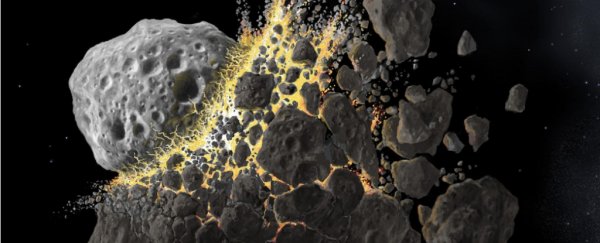In the beginning, the solar system was little more than a cloud of dust and gas. Then cold temperatures caused the center of the cloud to collapse, forming the Sun.
The newborn star lit up with nuclear fusion, sending light and heat out into the spinning circumstellar disk. Soon that material coalesced into gas planets, ice giants and rocky worlds, creating the solar system we know today.
For years, asteroids were thought of as the leftovers of planet formation — chunks of material that never quite made it to planet size and that were drawn into the crowded belt of rocky remnants that circles the Sun between Mars and Jupiter.
But according to a study published Monday in the journal Nature Astronomy, these were once pieces of worlds, too.
A vast majority of the half-million bodies in the inner asteroid belt may in fact be shrapnel from as few as five parent bodies called "planetesimals," scientists say.
But the tangled orbits of those lost worlds meant they were doomed to collide, producing fragments that also collided, producing still more fragments in a cataclysmic cascade that's been going on for more than 4 billion years.
The finding doesn't only illuminate a "mystery" of the asteroid belt, said Katherine Kretke, a planetary scientist at the Southwest Research Institute who was not involved in the study.
It could also help resolve a debate about the formation of the eight planets — including Earth.
"I find it really exciting that we can look back in time and potentially see evidence of what were the building blocks that built up our solar system," she said.
"If we can turn back the clock and see the asteroid belt was made by these big planetesimals, that really is telling us something quite definitive about the circumstances that formed our own planet."
The study's lead author, University of Florida astronomer Stanley Dermott, didn't necessarily set out to probe a mystery of solar system formation.
He and his colleagues were looking at data on the dynamics of bodies in the inner asteroid belt in hopes of figuring out what makes an object leave the belt — and potentially fly toward Earth. (For those who are concerned about asteroid collisions, rest assured that Dermott is still studying that question.)
But as Dermott began to look through a database of near-Earth objects, he noticed something strange about many large asteroids: Their orbits were inclined, or tilted, relative to the plane of the rest of the solar system.
"We couldn't think of any forces that are acting to produce that distribution," Dermott said.
On the other hand, "if a big asteroid is smashed up and it has a high inclination, then those fragments have that same inclination."
Scientists have previously known that roughly half of inner-belt asteroids belong to five "families." But Dermott and his colleagues say their analysis suggests that number is as high as 85 percent.
This finding matches other observations of the asteroid belt, said David Nesvorny, a planetary scientist at SWRI who was not involved with Dermott's study. Asteroids thought to belong to the same family tend to orbit in clusters and have similar chemical compositions.
There's an important, if apparent, implication of the idea that asteroids are actually fragments of larger bodies: "It means asteroids are born big," Nesvorny said.
That finding may help resolve a question about planet formation that has baffled scientists for years.
According to the traditional story of the origin of the solar system, the planets formed slowly from accretion, as particles in the circumstellar disk clumped together to great pebbles, then slightly larger spheres, on and on until they reached their current size.
But when scientists try to re-create this story with computer models, it breaks down.
Rather than growing, these incipient planets tend to splinter after reaching pebble size. How could this process result in bodies the size of those in the asteroid belt, let alone whole planets?
Enter the "born big" hypothesis.
Nesvorny and many others now think that gravity kicks in once clumps in the circumstellar disk reach the pebble stage, swiftly pulling together massive amounts of material to form a huge new planet.
In the inner solar system, this produced small, rocky planets such as Earth; further from the sun, we got gas giants.
But in the space between Mars and Jupiter, the tremendous gravity of the solar system's largest planet may have made it difficult to grow a large object, Nesvorny said.
The smaller bodies that did emerge, which were probably a tenth of the size of a planet such as Earth, could not have survived the ensuing chaos and collisions; they broke apart and formed the asteroid belt we know today.
Some questions remain about this theory. Tim McCoy, a geologist at the Smithsonian's National Museum of Natural History, pointed out that most meteorites that fall to Earth don't look like they come from large parent bodies.
And Kretke suggested that the theory might work better if there were a few dozen parent bodies, rather than just five.
Meanwhile, Nesvorny noted that the inner belt is home to only a tenth of all asteroids — he'd hope to see the analysis applied to the rest of the asteroid belt.
Dermott said he and his colleagues plan to address that question next.
And some day, he added, the research may be applied to other solar systems. Astronomers have found evidence for asteroid belts around Vega and Fomalhaut, stars just a couple dozen light-years away.
"That's the next big step, and it's happening in our lifetimes," Dermott said.
"The whole business of formation and evolution of planets and the question of 'What do we need to form an Earthlike planet elsewhere?' is something we can finally discuss in meaningful terms."
2018 © The Washington Post
This article was originally published by The Washington Post.
